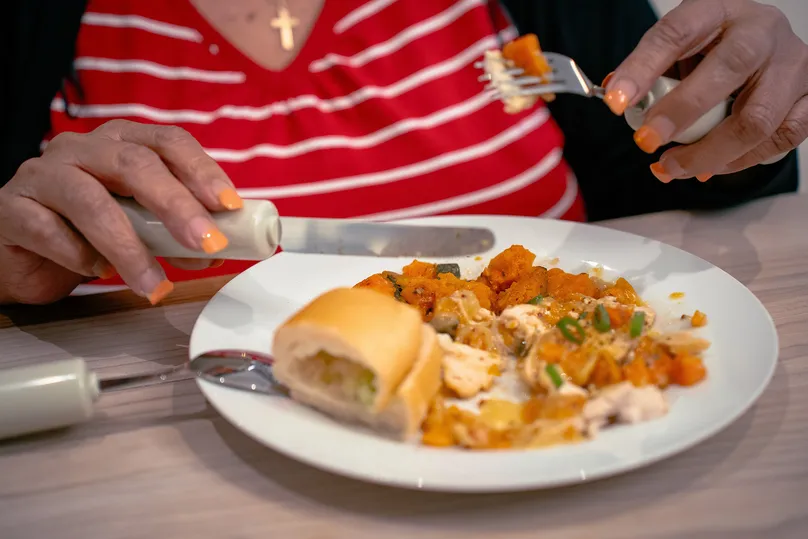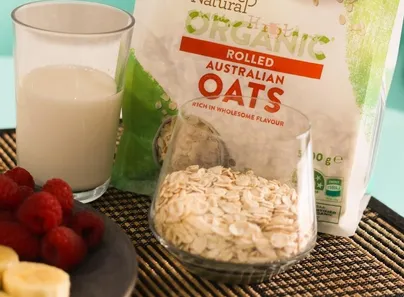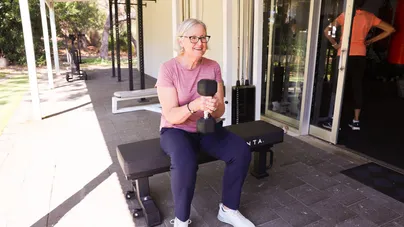1.2 million Australians are affected by osteoporosis. Here's how your diet can help prevent and manage this condition.

Osteoporosis is a common condition which causes bones to become fragile over time. Anyone can get osteoporosis, but women are at greater risk than men. For everyone, the risk for developing the disease increases with age.
The genes you inherit can cause osteoporosis. But so can smoking, excessive alcohol intake, not enough calcium or vitamin D, and not moving enough.
Osteoporosis can cause fractures or broken bones. This can affect your ability to move and stay independent. But, by making healthy choices, you can prevent and manage this condition.
What can I do?
Drinking less alcohol and quitting smoking helps. As does regular low-impact exercise, one of the most important things you can do for your health as you age. Moving your body every day improves and maintains bone health and density. Learn about exercise for osteoporosis.
Also consider exercises like Tai Chi and chair yoga for falls prevention. You can reduce your risk of fractures by doing balance exercises and building your muscle strength. You'll decrease your chances of falling, as well as your chances of injury in the event of a fall.
And of course, you can eat food that makes your muscles and bones stronger.
What should I eat?
It's best to minimise your intake of highly processed foods, which may be high in salt and saturated fats. Drinking too much caffeine or sugary fizzy drink is also associated with bone loss.
A balanced diet in general promotes good bone health. But for your bones, specifically, it's important to eat foods that are rich in calcium and vitamin D.
Calcium gives your bones strength and structure. But it's needed for other important things in your body, too, like your cardiovascular health. So, if you don't have enough calcium in your diet, your bones will give some up. And thus, they gradually lose density.
Vitamin D has many functions, too. Including helping you absorb calcium. It could also reduce your risk of fractures by increasing your muscle strength. Time in the sun is your biggest source of Vitamin D, though. So, get plenty of that. Be sure to stay hydrated and sun safe, of course!
Once you have enough calcium and Vitamin D, some other things like protein will support your bone health even further.
Higher protein diets increase calcium absorption and muscle mass, among other things, which can benefit your bones. But you need sufficient calcium in your diet to get the best of these benefits.
Wondering which foods to choose? Consider the following 10 foods for healthy bones.
Important safety notice
Some chronic conditions may make it so that certain foods aren't for you. Consult your doctor before trying a new diet.
What vegetables to eat
1. Dark leafy greens (cruciferous vegetables) provide fibre and many useful minerals for bone health. This includes calcium, but also potassium, which helps retain calcium in the bones. Ther's also magnesium, which helps activate your vitamin D. And it has some selenium, which is believed to be beneficial to bone health as well. Examples of cruciferous vegetables include bok choy, broccoli, kale, and spinach.
2. Tuberous root vegetables, like potatoes and sweet potatoes, can also be good for bone health. They're better for you when baked or boiled, rather than fried. They aren't especially high in calcium, but they can be a good source of other good things like potassium and magnesium. They also have vitamin C, which is needed to produce collagen in bones.
What meats to eat
Poultry and fish can be healthy sources of protein and calcium.
3. Canned fish such as canned wild salmon is a great source of calcium, magnesium, and healthy fat. The calcium content in a can is so high because it often includes extremely tiny bits of crushed bone. You can check the label to be sure it's wild (not farmed) and includes bone.
Farmed salmon has fewer nutrients, more calories, and a higher ratio of omega-6 to omega-3 fatty acids. This means it may be inflammatory and is best consumed in moderation, especially for older adults.
4. Chicken contains calcium and protein as well as many other good things. This includes zinc, choline, and amino acids. All these play a role in bone health.
Milks and 'milks'
Dairy products and plant-based milks all contain probiotics and prebiotics. These may modulate bone turnover, promoting better bone health.
5. Low-fat dairy products like skim milk, yoghurt, and cheese are also a great source of calcium. And they're often fortified with vitamin D.
However, some processed cheeses may have high sodium and polyphosphate. This would offset the benefits of their high calcium content. Acid-curd cheeses like cottage cheese are also high in sodium and relatively low in calcium and potassium. So, they don't build bone density.
6. Milk alternatives such as soy, almond, rice and oat milks also tend to be fortified with calcium and vitamin D. And they usually have low fat content as well. Just watch out for added sugar.
Legumes and nuts
Legumes and nuts are great for your bones and heart alike. Two great examples are soy and almond products.
7. Soybeans are low in fat, but high in calcium, protein, fibre, and isoflavones. Soy foods and isoflavones are indicated to help prevent and treat cancer and osteoporosis. Examples of soy foods include edamame, soy milk, and tofu.
8. Almonds are also high in calcium. Though almonds and almond butter may be high in calories as well, almond milk is usually watered down to a fat content of about 1%.
Fruits can make nutritious treats
Some foods may be high in sugars or fats, even if they're also full of bone-building nutrients. These would still make good treats, if consumed in moderation.
9. Citrus fruits and fruit juices have high vitamin C. Fruit juices are also often fortified with calcium. (And so are breakfast cereals!) But it pays to be conscious of your sugar intake, and always read the ingredients label.
10. Dried figs are another surprisingly rich source of calcium. They do have a high natural sugar content, too, but the fibre they provide helps offset this. Pair them with a high-protein, high-calcium, vitamin D-fortified cheese to create a very nutrient-rich treat. Bon appetite!
Bone density testing
You can also get bone density scans. It's recommended for women to get scans every two years, starting at 65. For men, testing is recommended from the age of 70. If osteoporosis risk factors are present, testing is recommended for women and men over 50.
More helpful information
If you would like to find local exercise classes, social activities, and helpful tips, try the quick quiz or call one of our helpful team for free today on 1800 951 971.
For more detailed information about osteoporosis click on these links:
References
Brzezińska, O., Łukasik, Z., Makowska, J., & Walczak, K. (2020). Role of Vitamin C in Osteoporosis Development and Treatment-A Literature Review. Nutrients, 12(8), 2394. https://pmc.ncbi.nlm.nih.gov/articles/PMC7469000/
Ceylan, M. N., Akdas, S., & Yazihan, N. (2021). Is Zinc an Important Trace Element on Bone-Related Diseases and Complications? A Meta-analysis and Systematic Review from Serum Level, Dietary Intake, and Supplementation Aspects. Biol Trace Elem Res, 199(2), 535-549. https://pubmed.ncbi.nlm.nih.gov/32451694/
Chen, L., Liu, R., Zhao, Y., & Shi, Z. (2020). High Consumption of Soft Drinks Is Associated with an Increased Risk of Fracture: A 7-Year Follow-Up Study. Nutrients, 12(2), 530. https://doi.org/10.3390/nu12020530
Chin, K. Y., & Ima-Nirwana, S. (2018). Vitamin C and Bone Health: Evidence from Cell, Animal and Human Studies. Curr Drug Targets, 19(5), 439-450. https://pubmed.ncbi.nlm.nih.gov/26343111/
Exercise & Sports Science Australia. (2023, May). How does exercise help osteoporosis? Exercise Right. https://exerciseright.com.au/osteoporosis
Ha, J., Kim, S. A., Lim, K., & Shin, S. (2020). The association of potassium intake with bone mineral density and the prevalence of osteoporosis among older Korean adults. Nutr Res Pract, 14(1), 55-61. https://pubmed.ncbi.nlm.nih.gov/32042374/
Healthy Bones Australia. (2020, November). Calcium and Bone Health. https://healthybonesaustralia.org.au/wp-content/uploads/2022/10/hba-fact-sheet-calcium.pdf
Healthy Bones Australia. Risk factors. https://healthybonesaustralia.org.au/your-bone-health/risk-factors/
Innes, J. K., & Calder, P. C. (2018). Omega-6 fatty acids and inflammation. Prostaglandins, leukotrienes, and essential fatty acids, 132, 41–48. https://doi.org/10.1016/j.plefa.2018.03.004
Jennings, A., MacGregor, A., Spector, T., & Cassidy, A. (2016). Amino Acid Intakes Are Associated With Bone Mineral Density and Prevalence of Low Bone Mass in Women: Evidence From Discordant Monozygotic Twins. J Bone Miner Res, 31(2), 326-335. https://academic.oup.com/jbmr/article/31/2/326/7605577
Jensen, I. J., Eilertsen, K. E., Otnæs, C. H. A., Mæhre, H. K., & Elvevoll, E. O. (2020). An Update on the Content of Fatty Acids, Dioxins, PCBs and Heavy Metals in Farmed, Escaped and Wild Atlantic Salmon (Salmo salar L.) in Norway. Foods (Basel, Switzerland), 9(12), 1901. https://doi.org/10.3390/foods9121901
Křížová, L., Dadáková, K., Kašparovská, J., & Kašparovský, T. (2019). Isoflavones. Molecules (Basel, Switzerland) 24(6), 1076. https://pubmed.ncbi.nlm.nih.gov/30893792/
Laird, E., Ward, M., McSorley, E., Strain, J. J., & Wallace, J. (2010). Vitamin D and bone health: Potential mechanisms. Nutrients, 2(7), 693-724. https://doi.org/10.3390/nu2070693
Manchali, S., Chidambara Murthy, K. N., & Patil, B. S. (2012). Crucial facts about health benefits of popular cruciferous vegetables. J Funct Foods, 4(1), 94-106. https://doi.org/10.1016/j.jff.2011.08.004
Mangano, K. M., Sahni, S., & Kerstetter, J. E. (2014). Dietary protein is beneficial to bone health under conditions of adequate calcium intake: An update on clinical research. Curr Opin Clin Nutr Metab Care, 17(1), 69-74. https://pmc.ncbi.nlm.nih.gov/articles/PMC4180248/
National Institute of Health. (2019). Osteoporosis. https://www.niams.nih.gov/health-topics/osteoporosis
Øyen, J., Gjesdal, C. G., Karlsson, T., Svingen, G. F., Tell, G. S., Strand, E., Drevon, C. A., Vinknes, K. J., Meyer, K., Ueland, P. M., & Nygård, O. (2017). Dietary choline intake is directly associated with bone mineral density in the Hordaland Health Study. J Nutr, 147(4), 572-578. https://pubmed.ncbi.nlm.nih.gov/28275104/
Raman, R. (2018, May). 7 Health and Nutrition Benefits of Potatoes. https://www.healthline.com/nutrition/benefits-of-potatoes
Ratajczak, A. E., Zawada, A., Rychter, A. M., Dobrowolska, A., & Krela-Kaźmierczak, I. (2021). Milk and dairy products: Good or bad for human bone? Practical dietary recommendations for the prevention and management of osteoporosis. Nutrients, 13(4), 1329. https://doi.org/10.3390/nu13041329
Rondanelli, M., Faliva, M. A., Tartara, A., Gasparri, C., Perna, S., Infantino, V., Riva, A., Petrangolini, G., & Peroni, G. (2021). An update on magnesium and bone health. Biometals, 34(4), 715-736. https://doi.org/10.1007/s10534-021-00305-0
Royal Osteoporosis Society. (2019). Are there any foods I should avoid? https://theros.org.uk/information-and-support/bone-health/nutrition-for-bones/are-there-any-foods-i-should-avoid/
Srinivasan, S., & Jha, A. (2020). Nutritional interventions for osteoporosis: A review. Frontiers in Nutrition, 7, Article 22. https://doi.org/10.3389/fnut.2020.00022
Streit, L. (2019, September). What's the difference between sweet potatoes and potatoes? https://www.healthline.com/nutrition/sweet-potato-vs-potato
U.S. Department of Agriculture, Agricultural Research Service. (2018). Salmon, canned, pink, with bones, drained (FDC ID: 174225). FoodData Central. https://fdc.nal.usda.gov/fdc-app.html#/food-details/174225/nutrients
University of South Australia. (2021). Caffeine cuts close to the bone when it comes to osteoporosis. https://www.unisa.edu.au/media-centre/Releases/2021/caffeine-cuts-close-to-the-bon--when-it-comes-to-osteoporosis/
Uwitonze, A. M., & Razzaque, M. S. (2018). Role of magnesium in vitamin D activation and function. J Am Osteopath Assoc, 118(3), 181-189. https://pubmed.ncbi.nlm.nih.gov/29480918/#:~:text=Magnesium%20assists%20in%20the%20activation,in%20the%20liver%20and%20kidneys
Weinsier, R. L., & Krumdieck, C. L. (2000). Dairy foods and bone health: Examination of the evidence. Am J Clin Nutr, 72(3), 681-689. https://doi.org/10.1093/ajcn/72.3.681
Yang, T., Lee, S. Y., Park, K. C., Park, S. H., Chung, J., & Lee, S. (2022). The effects of selenium on bone health: From element to therapeutics. Molecules, 27(2), 392. https://doi.org/10.3390/molecules27020392
LiveUp provides free information to help you make informed decisions about your health. This information is for general and educational purposes only, is not intended to provide a comprehensive guide, and does not replace medical advice. Everyone is different, so some of these tips may work better for you than others. You should use your own judgment and seek medical advice when applying this information to yourself, to determine if it is suitable in your circumstances. Your use of, or reliance on, this information is solely at your own risk. Independent Living Assessment Incorporated is not responsible or liable for any injury, loss, or damage caused as a result of your use of, or reliance on, this information.
Download and print this article:
You can print out the PDF and stick it to your fridge or file away the tips to revisit at a later time.

Read more Maintain my health articles
Did you enjoy this article? You may also like reading similar healthy ageing articles.
See all Maintain my health articles

